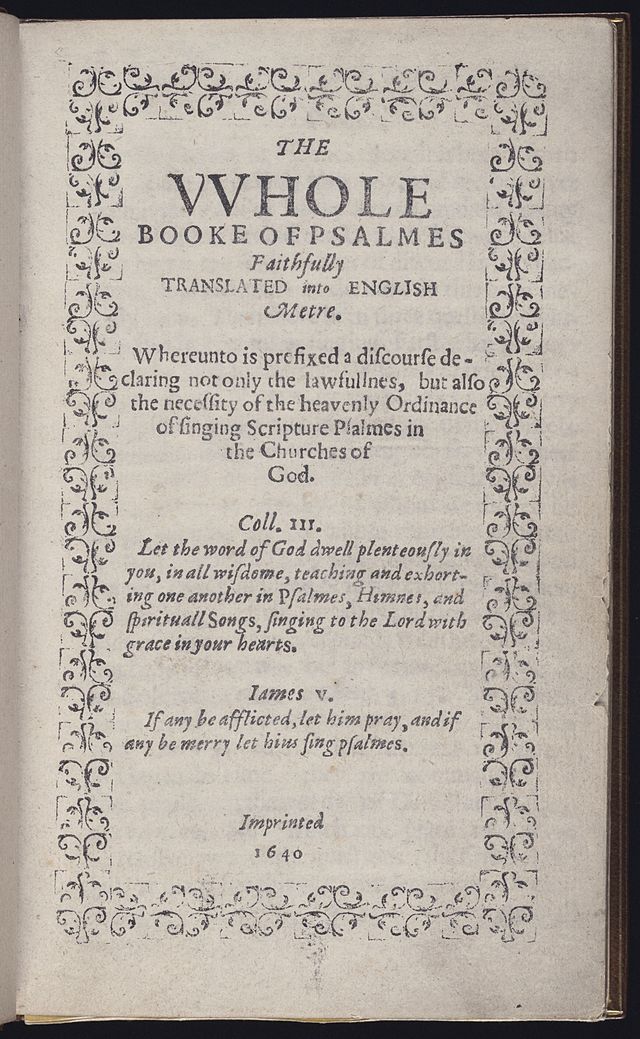Top Qs
Timeline
Chat
Perspective
Bay Psalm Book
Psalter first printed in 1640 in Cambridge, Massachusetts From Wikipedia, the free encyclopedia
Remove ads
The Whole Booke of Psalmes Faithfully Translated into English Metre, commonly called the Bay Psalm Book, is a metrical psalter first printed in 1640 in Cambridge, Colony of Massachusetts Bay. It was the first book printed in British North America.[1][2] The psalms in it are metrical translations into English. The translations are not particularly polished, and none have remained in use, although some of the tunes to which they were sung have survived. Its production, however, just 20 years after the Pilgrims' arrival at Plymouth, Massachusetts, represents a considerable achievement. It went through several editions and remained in use for well over a century.[3][4][5]


In November 2013, one of eleven known surviving copies of the first edition sold at auction for $14.2 million, a record for a printed book.[6][7][8]
Remove ads
History
Summarize
Perspective
17th century
The early residents of the Massachusetts Bay Colony brought with them several books of psalms: the Ainsworth Psalter (1612), compiled by Henry Ainsworth for use by Puritan "separatists" in Holland; the Ravenscroft Psalter (1621); and the Sternhold and Hopkins Psalter (1562), of which there were several editions. Evidently they were dissatisfied with the translations from Hebrew in these several psalters and wished for some that were closer to the original. They hired "thirty pious and learned Ministers", including Richard Mather, Thomas Mayhew, and John Eliot,[9] to undertake a new translation, which they presented here.[10] The tunes to be sung to the new translations were the familiar ones from their existing psalters.
The first printing was the third product of the printing press in Cambridge, the first and only press in the colonies, which was owned by Elizabeth Glover and managed by Stephen Daye. The book consisted of a 148 small quarto leaves, including a 12-page preface, "The Psalmes in Metre", "An Admonition to the Reader", and an extensive list of errata headed "Faults escaped in printing". Subsequent editions were explicitly printed for sale in Boston by the first bookseller in British America, Hezekiah Usher, and it is hypothesized that Usher may have also intended to sell this first edition from his shop in Cambridge.[11] An estimated 1,700 copies of the first edition were printed.[12]
The third edition (1651) was extensively revised by Henry Dunster and Richard Lyon. The revision was entitled The Psalms, hymns and spiritual songs of the Old and New Testament, faithfully translated into English metre. This revision was the basis for all subsequent editions, and was popularly known as the New England Psalter or New England Version. The ninth edition (1698), the first to contain notated music (rather than simply identifying tunes by name), included 13 tunes from John Playford's A Breefe Introduction to the Skill of Musick (London, 1654).[13]
18th century
The expansion of the neoclassical movement in England led to an evolution in the singing of psalms. These changes found their way to America and subsequently new psalm versions were written. In the early part of the 18th century, several updated psalms, notably those written by Tate and Brady and by Isaac Watts, were published. Shortly thereafter several congregations in New England elected to replace the Bay Psalm Book with these new titles.
In 1718, Cotton Mather undertook the revision of the original Bay Psalm Book which he had studied since youth. Two subsequent revisions were published in 1752, by John Barnard of Marblehead and in 1758 by Thomas Prince. Prince was a clergyman at the Old South Church in Boston. He convinced the members of the congregation of the need to produce a revised, more scholarly, edition of the Bay Psalm Book. However, Prince's version was not accepted outside of his membership and in 1789, the Old South Church reverted to the earlier edition published by Isaac Watts.[14]
Remove ads
Title page
The title page of the first edition of 1640 reads:
The Whole Booke of Psalmes
Faithfully
TRANSLATED into ENGLISH
Metre.
Whereunto is prefixed a discourse
declaring not only the lawfullness, but also
the necessity of the heavenly Ordinance
of singing Scripture Psalmes in
the Churches of God.
An example of the text
"Psalm 23" provides an example of the translation, style and versification of the text of the Bay Psalm Book:
The Lord to me a shepherd is,
want therefore shall not I:
He in the folds of tender grass,
doth cause me down to lie:
To waters calm me gently leads
restore my soul doth he:
He doth in paths of righteousness
for his name’s sake lead me.
Yea, though in valley of death’s shade
I walk, none ill I’ll fear:
Because thou art with me, thy rod,
and staff my comfort are.
For me a table thou hast spread,
in presence of my foes:
Thou dost anoint my head with oil;
my cup it overflows.
Goodness and mercy surely shall
all my days follow me:
And in the Lord’s house I shall dwell
so long as days shall be.[15]
Extant copies and auction records
Summarize
Perspective
Eleven copies of the first edition of the Bay Psalm Book are still known to exist,[16] of which only five copies are complete. Only one of the eleven copies is currently held outside the United States. One copy is owned by each of the following:[17]
Remove ads
See also
- Codex Leicester, which holds the record for the sale price of any book[6]
- Metrical psalter
- List of most expensive books and manuscripts
Notes
Further reading
External links
Wikiwand - on
Seamless Wikipedia browsing. On steroids.
Remove ads





